The Economics and Statistics Division maintains archives of previous publications for accountability purposes, but makes no updates to keep these documents current with the latest data revisions from Statistics Canada. As a result, information in older documents may not be accurate. Please exercise caution when referring to older documents. For the latest information and historical data, please contact the individual listed to the right.
<--- Return to Archive
For additional information relating to this article, please contact:
September 25, 2024NOVA SCOTIA ANNUAL POPULATION ESTIMATES AS OF JULY 1, 2024 Note: population estimates for July 1 and components of population change in the 12 months up to July 1 are conventionally referred to as 'annual' population estimates.
As of July 1, 2024, Nova Scotia's population was estimated to be 1,076,374, an increase of 19,888 (+1.88%) over the revised July 1, 2024 estimate (1,056,486).
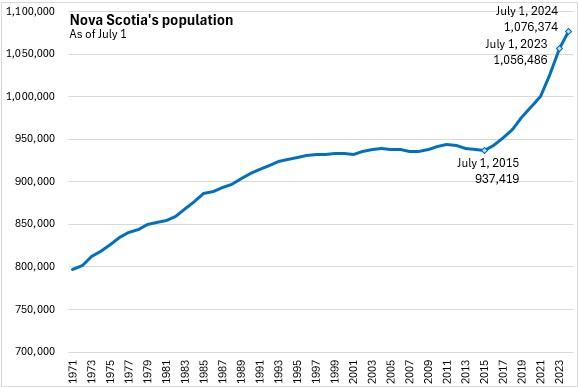
National population growth was up 3.01% from July 1, 2023 to July 1, 2024. The fastest growth was observed in Alberta while the slowest population gains were in Newfoundland and Labrador and Nova Scotia.
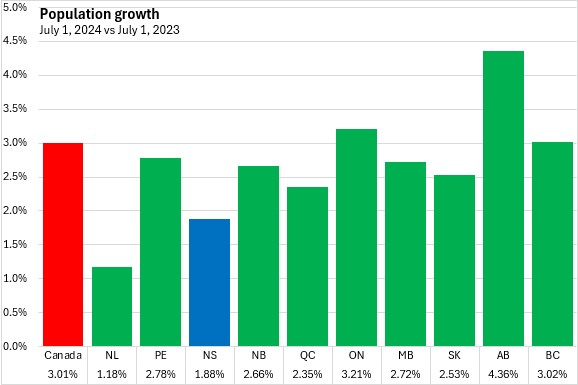
Nova Scotia's July 1, 2023 to July 1, 2024 population increase was 19,888. Although this was slower population growth than in the two previous years, it was still faster than any years prior to 2022.
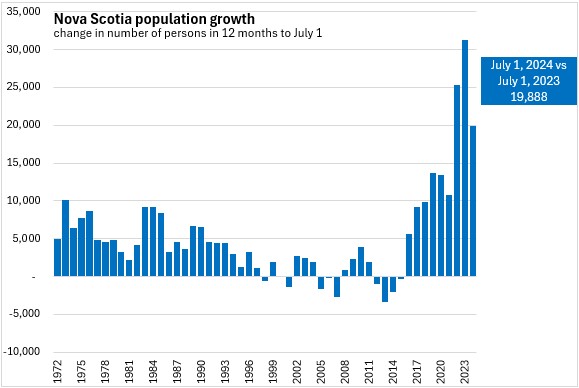
In percentage terms, Nova Scotia's growth of 1.88% was the fifth fastest growth in records dating back over a century.
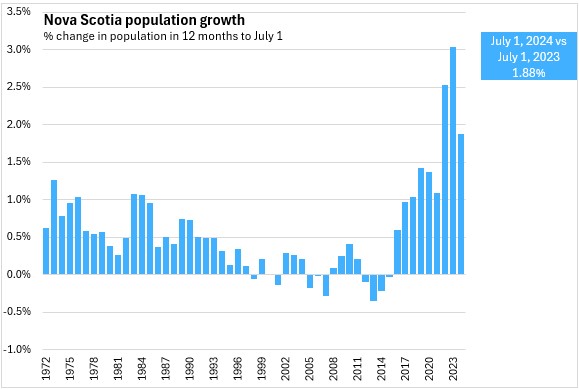
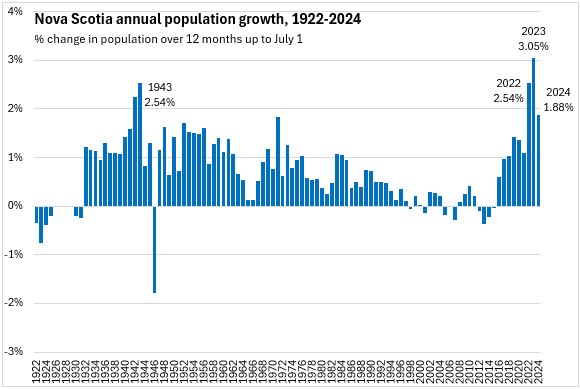
Nova Scotia's population growth was attributable to a continued inflow of non-permanent residents (+24,221 offset by non-permanent resident expenditures of 15,476) as well as strong immigration (13,736). Interprovincial in-migration slowed considerably to +17,748, offset by 15,496 interprovincial out-migrants. There were a small number of emigrants leaving Nova Scotia for another country (489). The pace of births slowed to 7,499 while deaths rose to 11,855.
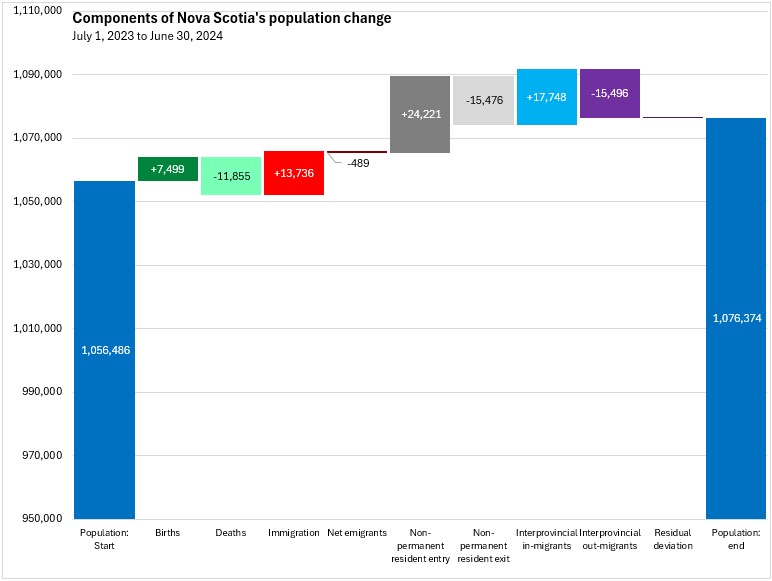
When measured as a percentage of the population on July 1, 2023, Nova Scotia reported less population growth as a result of births and steeper population decline as a result of deaths. Although Canada's national population was still increasing because of natural population change (births less deaths), deaths outnumbered births in all Atlantic provinces as well as in Québec and British Columbia.
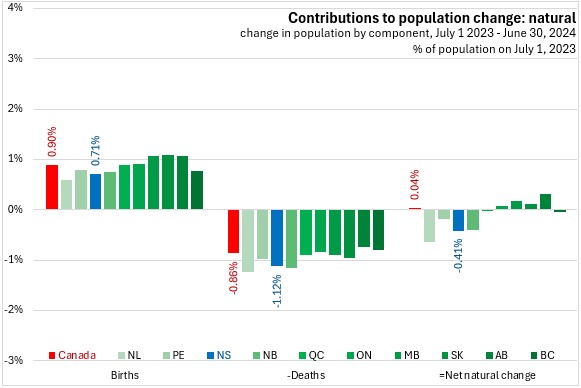
International migration is the main contributor to Canada's population growth. Measured as a share of the July 1, 2023 population immigration contributed about the slightly more to Nova Scotia's population growth than it contributed to national population growth. Prince Edward Island reported the largest contribution to population gain from immigration while Québec reported the least contribution from immigration.
Net emigration (including returning emigrants) was a comparatively small drain on the population for all provinces.
All provinces reported a substantial contribution to population growth as a result of net change in non-permanent residents, led by Ontario and British Columbia. The contribution of net non-permanent residents to population change was slower in Nova Scotia than at the national level. Prince Edward Island reported the smallest contribution to population change from non-permanent residents.
Considering immigration, net emigration and non-permanent residents, all provinces reported net international population gains, led by Ontario and British Columbia.
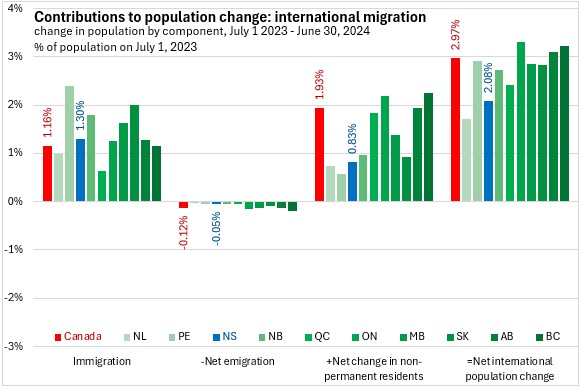
Nova Scotia reported a larger than average contribution to population change as a result of interprovincial in-migration (measured as a percentage of July 1, 2023 population). Out-migration to other provinces was a larger drain on Nova Scotia's population than the national average. Alberta and the Atlantic provinces reported the strongest contributions to population growth from net interprovincial migration. Saskatchewan reported the largest percentage decline as a result of net interprovincial migration.
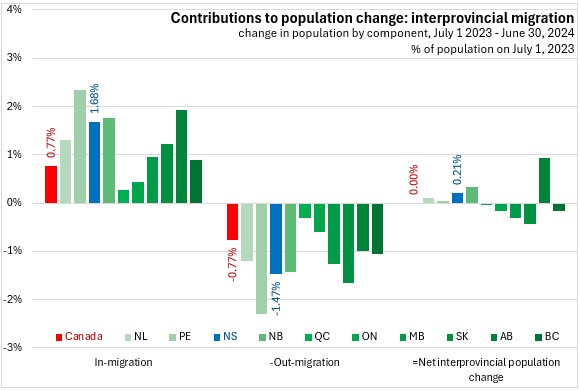
Natural population change (births less deaths) continued to put downward pressure on Nova Scotia's population. From July 1, 2023 to July 1, 2024 there were 7,499 births and 11,855 deaths, resulting in a net natural population change of -4,356 over this period.
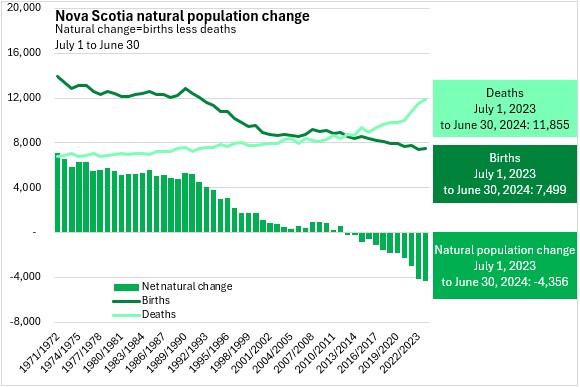
From July 1, 2023 to July 1, 2024, Nova Scotia reported 13,736 immigrants coming to the province. This was down slightly from the record immigration reported two years ago.
Net emigration resulted in 489 persons moving from the province to another country between July 1, 2023 and July 1, 2024.
The change in non-permanent residents (which includes students and temporary foreign workers) was a gain of 8,745 persons, considerably slower than the increase reported in the previous year.
Accounting for the decline resulting from net emigration and the gains from immigrants and non-permanent residents, the net international population change for Nova Scotia was +21,992 from July 1, 2023 to July 1, 2024 - a substantial decline from the previous 12 months.
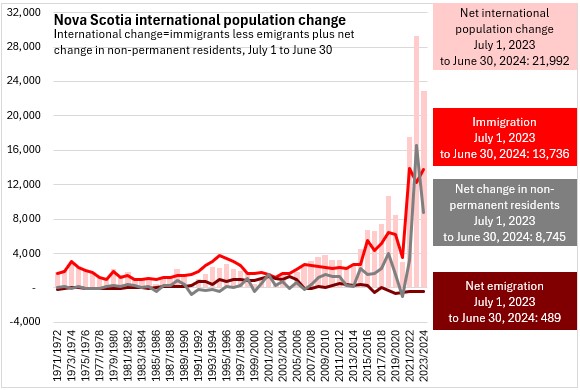
Nova Scotia's immigration levels remain near their all-time highs.
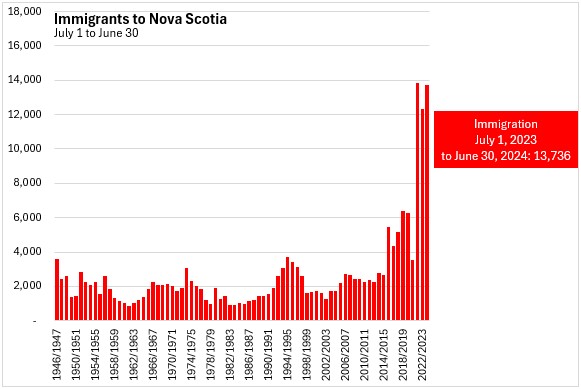
Net change in non-permanent residents have slowed, but are still a strong contributor to Nova Scotia's population.
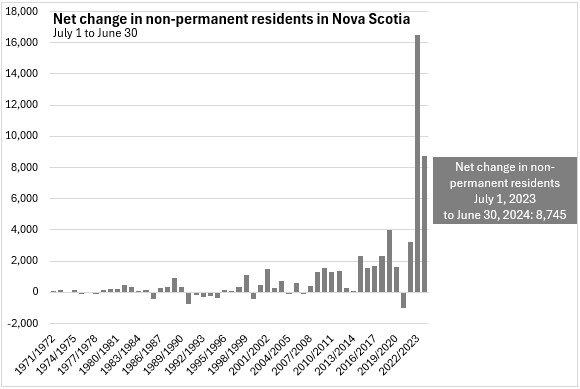
The period from July 1, 2023 to July 1, 2024 marked the ninhth consecutive year of positive net interprovincial migration to Nova Scotia. However, the pace of in-migration and net migration has slowed in each of the last two years for every age cohort. Net migration for those aged 15-34 has turned negative (-51). The number of in-migrants to Nova Scotia from other provinces contracted sizably to 17,748 while the number of out-migrants from Nova Scotia edged down to 15,496.
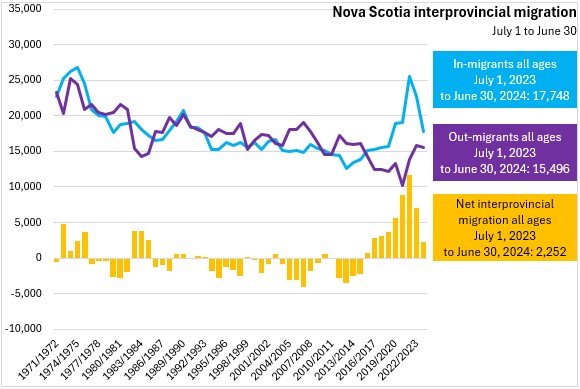
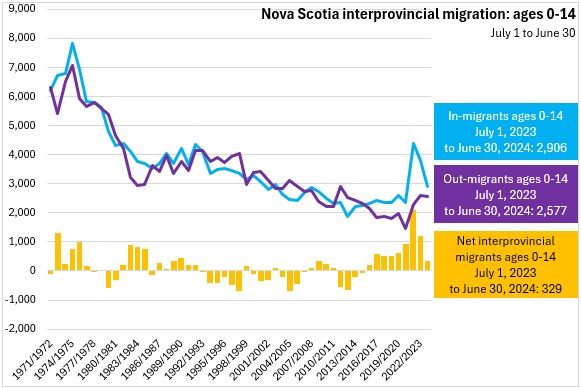
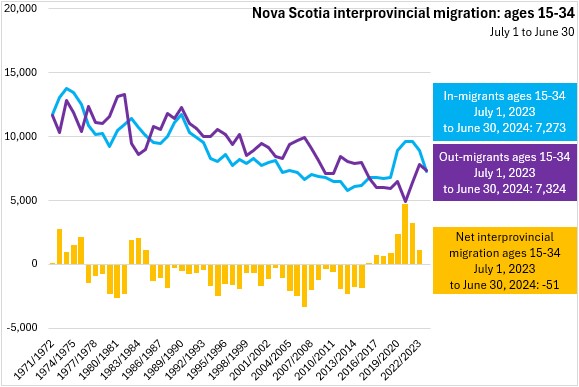
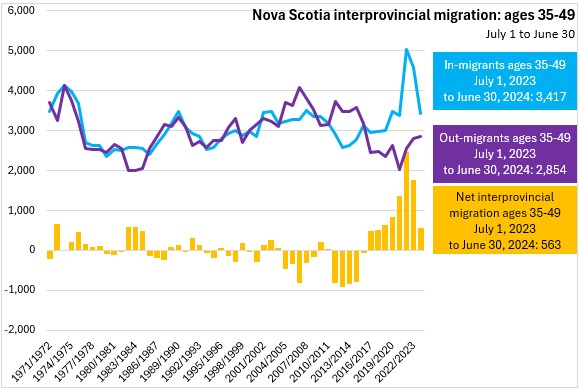
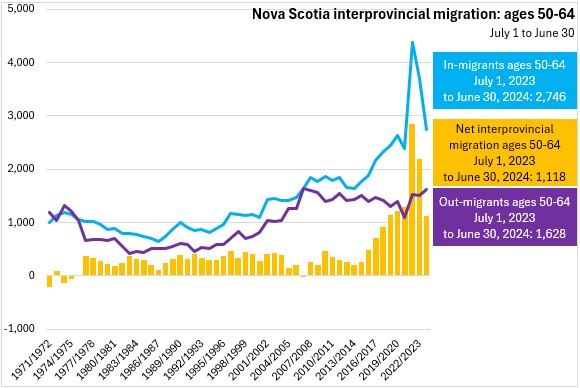
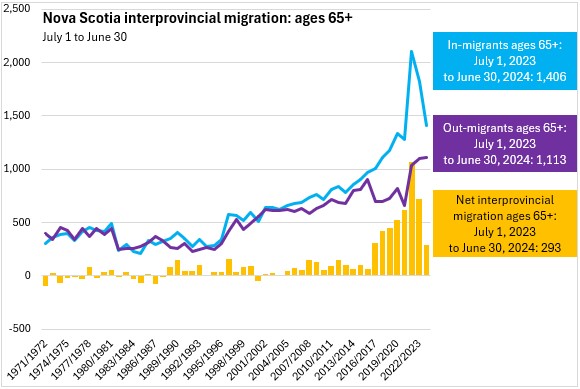
Volatility in Nova Scotia's net migration is often driven by those aged 15-34, who exhibit greater mobility. Although this cohort had previously been the source of substantial interprovincial population increases, the number of out-migrants aged 15-34 now exceeds the number of in-migrants of similar ages.
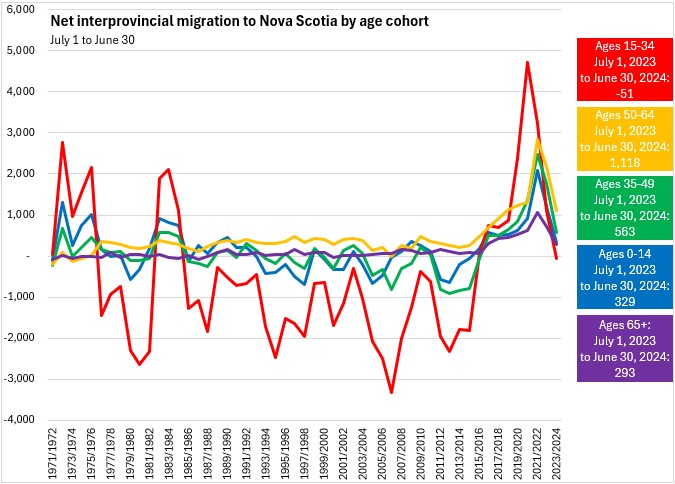
By source and destination, the largest source of net interprovincial migration to Nova Scotia was Ontario (+2,522) while the largest net outflow from Nova Scotia was to Alberta (-1,382).
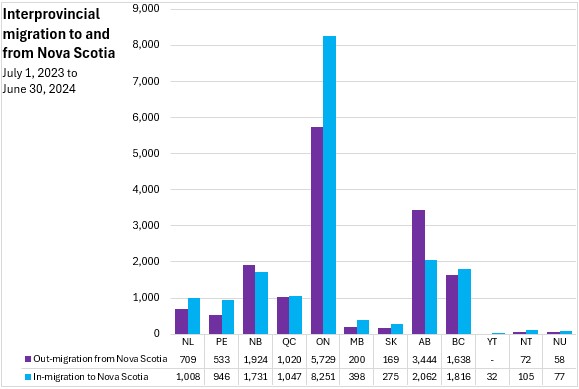
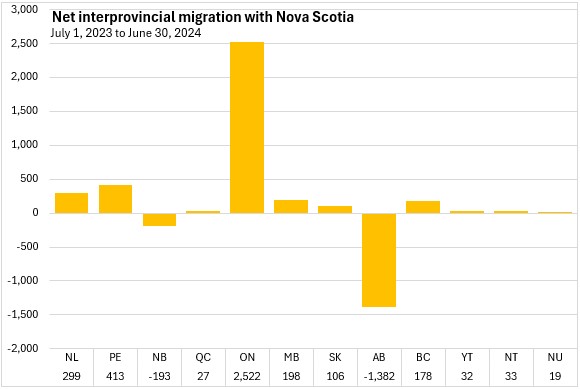
After a sharp rise in in-migration to Nova Scotia from Ontario over the past decade, the pace of in-migration has cooled again. In-migration from Alberta, British Columbia, Québec and New Brunswick has also fallen.
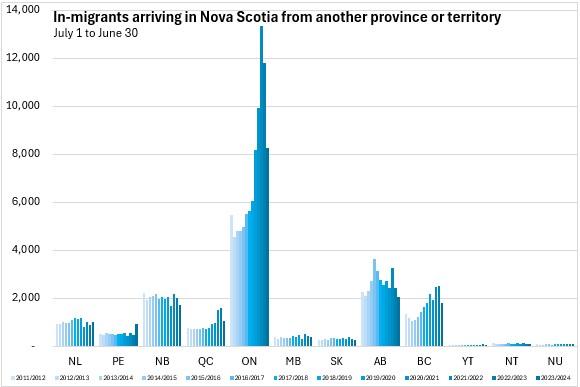
From July 1, 2023 to July 1, 2024, Ontario continued to be the largest destination for out-migrants leaving Nova Scotia. There were notable increases in out-migration from Nova Scotia to Alberta.
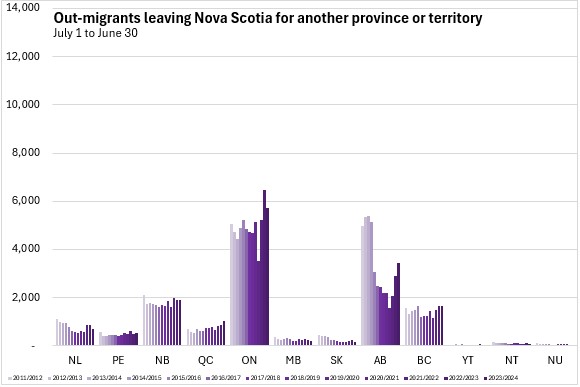
Interprovincial migration with Alberta has again become a net drain for Nova Scotia.
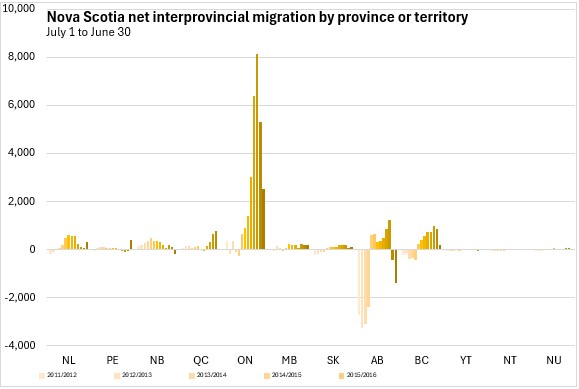
With significant increases in immigration and interprovincial in-migration of younger cohorts, Nova Scotia's median age has contracted substantially - falling from 43.8 years as of July 1, 2023 to 43.5 years as of July 1, 2024. This was still the third highest median age among provinces after Newfoundland and Labrador and New Brunswick. The national median age was 40.3 years with the lowest median age in Manitoba (37.3 years).

Nova Scotia's median age has not increased since 2018.
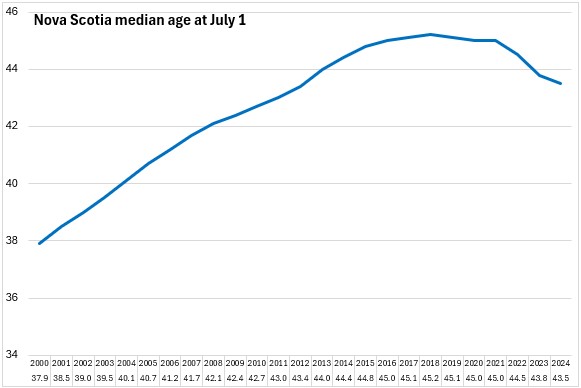
Nova Scotia's population last experienced an extended decline in median age during the late 1950s and early 1960s following elevated births from the baby boom.
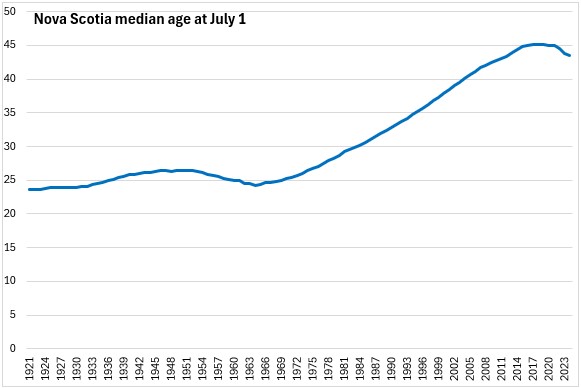
Immigration and net interprovincial migration have contributed to a reversal in declining populations of Nova Scotia's younger cohorts, particularly for those aged 0-17, 15-34 and 35-49.
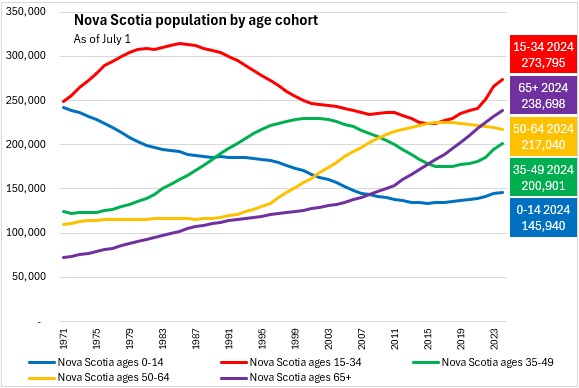

Despite a revival of growth among younger population cohorts in Nova Scotia, the population pyramid shows an older population than the national age distribution.
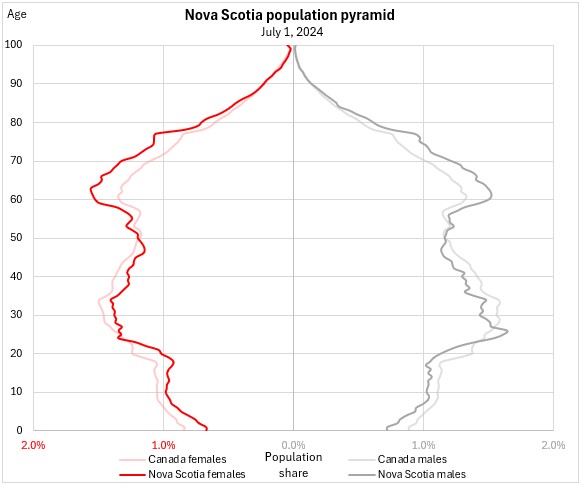
Source: Statistics Canada. Table 17-10-0005-01 Population estimates on July 1st, by age and sex, Table 17-10-0008-01 Estimates of the components of demographic growth, annual, Table 17-10-0014-01 Estimates of the components of international migration, by age and sex, annual, Table 17-10-0015-01 Estimates of the components of interprovincial migration, by age and sex, annual, Table 17-10-0022-01 Estimates of interprovincial migrants by province or territory of origin and destination, annual, Table 17-10-0009-01 Population estimates, quarterly, Table 17-10-0040-01 Estimates of the components of international migration, quarterly, Table 17-10-0020-01 Estimates of the components of interprovincial migration, quarterly
<--- Return to Archive